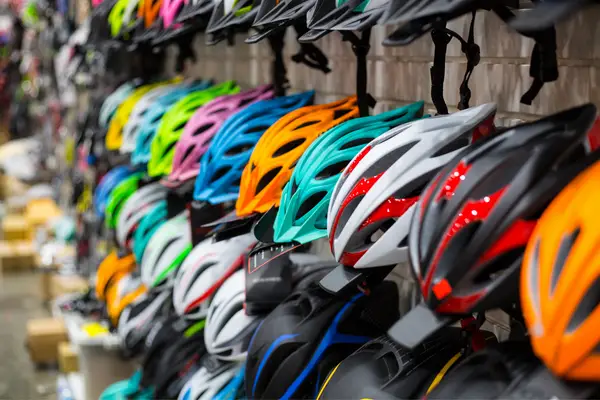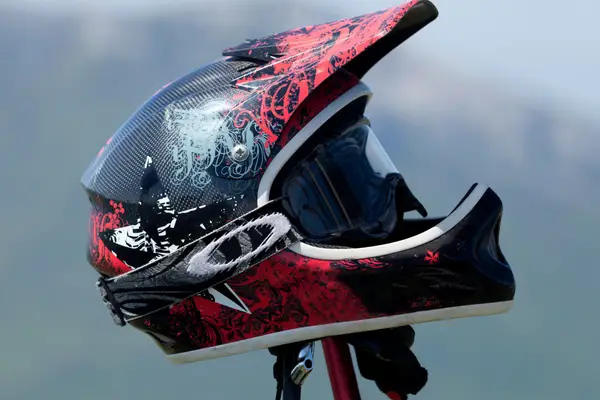Helmets are vital as they reduce the risk of brain injury and death by taking the brunt of the crash impact. However, choosing a fitting helmet is just as crucial as wearing one.
This article will look at the two most common types of bike helmets – Road bike helmets and mountain bike helmets. What are their features, and how are they different from one another? Keep reading to learn more.
Mountain Bike Helmets

Since mountain bike riders are more likely to fall than road riders, mountain bike helmets are well-vented, and most types offer increased rear head covering.
Due to the constantly shifting lighting and other environmental conditions seen off-road and in forested locations, they typically have visors.
They usually extend lower down the back of the head (than road bike helmets) on technical terrain to provide full head coverage.
Mountain Bike Helmet Features
MTB helmets come with various features and technological advancements, all designed to keep your head safe when riding a trail bike.
Helmets explicitly made for mountain biking will have more head coverage than road bike helmets because protection is their primary role.

The MTB helmet is available in various sizes, and each size can be adjusted for the ideal fit.
They come with chin straps and a fit adjuster for adjusting the fit. You may fasten the bicycle helmet to your head with the help of simple-to-adjust straps.
Road Bike Helmets

Road bike helmets are made to be light, breathable, and aerodynamic. They are more aerodynamically designed and have larger air vents for better ventilation.
Road Bike Helmet Features
The road bike helmet is made of a tough polycarbonate shell that safeguards the biker’s head if there’s a collision.

A road bike helmet also has chin straps, which help to fit the helmet to the wearer’s head. The vents will keep the head cool throughout the entire ride, in the meantime.
Generally, a road bike helmet weighs less than a mountain bike helmet. A biker will have less fatigue after the bike ride if their helmet is lightweight.
Related: Why MTB helmets have visors?
Mountain bike helmet vs. road bike helmet: Differences
Listed below are the differences between MTB helmets and road bike helmets.
Size

Given that mountain biking is riskier than road biking, mountain bike helmets are often larger than road bike helmets to provide more safety and protection.
Road helmets feature a thinner liner and a smaller shell width, but mountain bike helmets are often broader and bulkier.
Shape

The shape is one of the primary differences between road cycling helmets and mountain bike helmets. Compared to the more sleek, aerodynamic, well-ventilated road bike helmets, mountain biking helmets have a visor, a bulkier shape, and a low-cut rear.
Protection
Although some safety measures are similar, they are made to handle completely different kinds of collisions. MTB helmets provide more head protection than road helmets
Overall, more injuries are avoided by special safety measures like MIPS than by the helmet’s design.
The more aggressive design of a mountain bike helmet features excellent coverage and sharper edges.
Road helmets, meanwhile, are more streamlined and thin. They also have a lower profile design to increase their aerodynamic properties.
Visor

Since the most ardent MTBers prefer to ride in the mountains, MTB helmets frequently come with visors to shield the rider from the sun.
However, there are few opportunities for such foreign items to fly when road biking, and from the perspectives of aerodynamics and convenience of removal, the sun is frequently shielded by eyeglasses, and only a small minority of helmets come with visors.
Although wearing a visor while riding a road bike is appropriate, there aren’t many road helmets, partly because they’re frequently made of lightweight materials.
Types
Mountain bike helmets come in a variety of styles. There is only one type of road helmet at the moment.
A full-face mountain bike is similar to the ones you see motorcycle riders wearing, but it is smaller and more lightweight. These are utilized for downhill and endurance riding.

However, because half-shell helmets are lighter and more breathable, enduro riders occasionally wear them.
Another option is a full-face mountain bike helmet with a detachable chin guard that you can take off when climbing hills and reinstall when down fast descents.
Aerodynamics
Road riding relies heavily on having as little wind resistance as possible. Less so with mountain biking, when the majority of the time is spent slowly pedaling uphill.
The general water drop shape, lack of a visor, and thin profile help the road bike perform aerodynamically better.
Compatibility with sunglasses or eyewear
The proper eyewear is essential for the job at hand. Not just to maintain good eyesight but also to shield the eyes from foreign objects and sunlight. Any biker should have it, and headgear is created with either sunglasses or goggles in mind.
For the straps to fit snugly, goggles need 2 inches of a flat surface extending from the sides over the back. Additionally, there is some space between the eyebrows and the top of the helmet.

Few MTB helmets can be worn with sunglasses, although most may be worn with goggles.
Regular sunglasses will develop pressure points on their frames when worn with any over-ear or full-face helmet.
Some eyewear is more compact and made to go beneath helmets. They frequently have larger lenses that extend up to the helmet, similar to road bike glasses. Consequently, a combination is still possible.
Weight
MTB helmets are heavier than road helmets because they have more actual material in them. The hefty design’s thick shell and enlarged rear provide most of the extra weight.
This is a crucial factor in developing specific cross-country mountain bike helmets that resemble road helmets in appearance and comfort. Only the low-cut rear stems back to the sport’s mountain riding origins, despite the absence of visors and the sleek aesthetics.
Price
Road bike helmets are often more costly than MTB helmets since they are designed to provide adequate airflow without sacrificing safety.
Most mountain bike helmets are priced between $30 to $300 and are available at independent bike shops. On the other hand, road bike helmets can cost anywhere from $50 to $500 and more.
Related: Fat Bike vs MTB
Should you use a road bike helmet for MTB? Or vice versa?

So, is a mountain bike helmet suitable for road cycling? It’s not ideal, but definitely doable. It’s better than not wearing a helmet at all.
Here are some factors to consider when deciding whether to ride a road bike while wearing an MTB helmet:
- As it is heavier, you will move more slowly.
- Wear it if it’s the only helmet you have.
- If you can, invest in a road bike helmet. You’ll benefit from it much more when riding on the highway.
Related: Should you ride MTB on road?
What about road bike helmets for mountain biking?
Road and mountain bike helmets are designed to protect your head in the case of an accident. A road bike helmet can be used when riding a mountain bike. But remember that every helmet design has components that enhance performance, durability, and safety for every distinct riding style.
However, consider investing in a full-face mountain bike helmet if you intend to ride downhill at a mountain or ski resort. They cover your entire chin and mouth area and resemble motorcycle helmets. This provides an additional layer of security.

The riskiest type of mountain biking is downhill riding. You are riding on bumpy, hilly terrain where you can easily lose control.
Mountain biking downhill significantly increases your risk of falling. Wear a full-face MTB helmet as a precautionary measure at all times.
Related: Open face vs full face MTB helmet
Final Thoughts
In the cycling community, there is much discussion on whether road bike helmets or mountain bike helmets are preferable for cyclists.
Some claim that they provide more protection because MTB helmets are larger and have a larger coverage area. Others argue that since road bike helmets are more aerodynamic, they provide riders an advantage when competing.
The choice ultimately comes down to your personal preference. Some people find wearing an MTB helmet safer, while others favor the modern style and fit of a road bike helmet.


